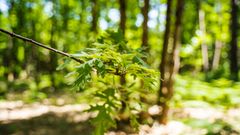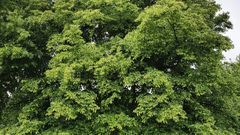

The birch, or Betula pendula, is a member of the Betulaceae family and known by various names in Europe. It is commonly known as the warty birch or white birch and sometimes as the paper birch, silver birch, or weeping birch. This species is widespread in the temperate forests of the northern hemisphere. It is particularly appreciated for its bark's characteristic white colour and light, flexible wood.
The birch, a pioneer species of significant ecological importance, quickly colonises poor, virgin land, even after a fire. It often forms the first tree formation when heathland is reclaimed or colonised by forest, showcasing its role in ecological succession.
It adapts to various soil types but prefers well-drained, slightly acidic soils. Birch often grows in open environments such as forest clearings and edges.
In a temperate climate, birch trees live for no more than 30 to 40 years, but in the Nordic countries (Sweden, Finland, Russia) they can live for 100 years or more.
Birch grows on poor, siliceous soils and can grow at altitudes of up to 2,000 metres and in Arctic regions. This tall, slender tree, which can grow to 30 metres, is fast-growing and highly resistant to the cold.
Birch reproduces using small, inconspicuous flowers grouped into catkins. Male and female catkins develop on the same tree, with the males hanging down and the females erect. After pollination, the fruits, called samaras, are dispersed by the wind.
In the Palaeolithic era, humans used Birch bark as an adhesive. It was obtained by dry distillation of the bark. In Northern Europe, Birch bark was plaited into strips and used to make shoes. It was also used as a writing surface in Russia.
Because it burns quickly without burning too hot and leaves very little ash, bakers much appreciated it and even called it baker's wood.
Birch is also highly regarded in alternative medicine. Its sap has great detoxifying and regenerating properties. Its bark and leaves can be made into herbal teas. The bark has anti-inflammatory, anti-infectious, antibacterial, and analgesic properties. An infusion of the leaves also works well and is easier to obtain. It also has a significant diuretic effect.
Birch juice, obtained by decoction of the leaves or bark, is rich in vitamin C and trace elements. Many pharmacies and organic shops now sell it. One can also harvest Birch water and sap from the tree in early spring. This highly fashionable, more concentrated drink is an excellent purifier and depurative, cleansing the body of toxins. It is ideal for treating acne, for example. It also frees the gall bladder and the liver, two of the primary receptacles of emotions, particularly anger and irritability.
In many cultures, the Birch tree symbolises renewal and purification. In Eastern Europe, for example, it is often associated with spring rituals and folk traditions. Once revered by Amerindian and Scandinavian peoples, it is celebrated in Russia as the national tree. A symbol of wisdom, purification and rebirth, it is the tree of life.
Our goal is to enable anyone to do something that benefits nature and helps us to live in a more harmonious world. So why not become a tree owner in a European forest and help combat climate change?






Please note that this is promotional communication. See our notice of information.